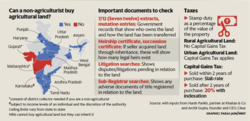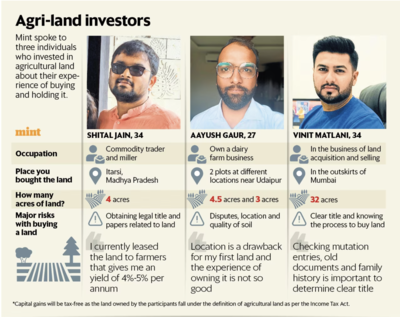Mint | 4 July 2023
Agri-investment comes with risks. Look at Growpital
by Satya Sontanam and Neil Borate
New Delhi: A new agri-investment platform claims to offer tax-free assured returns of 10-15% on investments. It is open to retail investors with a minimum investment of ₹5,000 and also allows non-resident Indians (NRIs) to invest.
New Delhi: A new agri-investment platform claims to offer tax-free assured returns of 10-15% on investments. It is open to retail investors with a minimum investment of ₹5,000 and also allows non-resident Indians (NRIs) to invest.
Despite having been in existence for six years, the firm started collecting money from the public only in the last two years. It has raised approximately ₹70 crore, which has been deployed over an area of more than 3,000 acre of land. Currently, over 2,000 investors have subscribed to this platform, according to the firm.Since the returns are in the form of agricultural income, they are exempt under the Income Tax Act, 1961, in India. As a result, the income in the hands of investors is also tax-exempt. However, there are certain risks that investors need to take note of due to its operating structure.
Here, we outline how Growpital works, based on information from its website and an interaction with its founder, Rituraj Sharma, and highlight the potential risks associated with such investments.
1. What is Growpital?
Growpital is an agricultural investment platform that claims to offer tax-free fixed-profit sharing to investors ranging from 10% to 15% on investments.
The funds are invested in agricultural project portfolios, where investor capital serves as working capital for farming.
The platform manages farm projects either through an in-house team or by partnering established market players. The firm ties up with farmers and provides standard operating procedures to them on farming.
Growpital compares itself to a mutual fund, with diversified crops being grown across farm projects.
2. How will Growpital utilize the funds?
It utilizes funds to take lands on lease in different parts of the country and develop the basic minimal infrastructure, which can be used for irrigation. By selling the crop produce, the firm earns revenue.
The firm’s costs include lease rental to landlords, other working capital costs of farming, fixed payment to farmers and fixed profit sharing to investors.
3. Why are the returns called profit sharing?
Growpital designed LLPs (Limited Liability Partnership) to collect funds. Your investment is considered a capital contribution and you become a partner in LLP. The asset (farm projects) is owned by the LLP and all the partners in the LLP are considered legal co-owners, as per the firm.
You get fractional ownership of the farm projects under your name as per the amount invested by you.
Note that since your income will be in the form of business income, the investor needs to file a specific ITR return showing income under business or profession.
4. Who bears the price risk and weather risk associated with farming?
The risk will be borne by Growpital. But the company claims to reduce these risks by investing in varied crops across 11 states including Rajasthan, Madhya Pradesh, Maharashtra, Karnataka, Odisha, Bihar, Uttar Pradesh, Kerala, Chhattisgarh, Haryana, Chandigarh.
5. Why is it not under a collective investment scheme?
According to the founder of the firm, under a collective investment scheme (CIS), there is a lack of control by an investor over the funds allocated to any activity. However, in Growpital’s case, there are certain powers vested in the partners. For instance, important decisions such as obtaining a loan or debt from a bank require approval from more than 60% of the partners in the LLP, added Sharma.
6. Is there any lock-in period for investments?
For most plans listed on Growpital’s platform, there is a lock-in period of 12 months.
If you withdraw before the committed period ends, the project entity would deduct all payouts given to you from the original investment amount and pay the remaining amount to you.
However, if you make any withdrawal request after the committed period and before the maturity period, the original investment amount shall be repaid.
7. How liquid are the investments?
The firm claims to offer quick liquidity if the investor wants to exit. In an interview with Mint, the founder of Growpital, Rituraj Sharma, said that they keep enough buffer that even if all the investments are withdrawn on the same day, the firm will be able to pay 65% of capital back, while the rest will be paid in 3-4 months of time as the revenue from existing standing crop or inventory realizes.
8. What are the risks with its structure?
It is important to understand the terms and conditions of the partnership agreement that an investor enters with the firm.
Generally, a partner in a firm has a share in both profits and losses of the firm.
If Growpital offers assured returns of 10%-15%, it is important to make sure if the partnership is exempt from taking losses. Otherwise, there is a risk of investors incurring losses on capital invested if the fund does not generate the desired results.
When investing in any financial product, it is important to understand how the fund will be utilized. While the generic information is presented by the company on its website, it is important to verify the books to ascertain the authenticity of promises made. Being an LLP, its information will not be directly available in the public domain. So, one needs to ask if there is a right to access books/accounts of the firm as a partner.
Further, where retail investors’ money is involved, crowdfunding would be scrutinized strictly by the government or regulators in the interest of investors.
If principles of partnership are not followed by providing assured returns (which takes the form of a loan), there could be a possibility of Growpital's investment process being categorized as an unregulated deposits scheme. Note that as an LLP, the firm is covered under the Ministry of Corporate Affairs and not regulated by Securities and Exchange Board of India, which governs and regulates most of the financial products in India.













